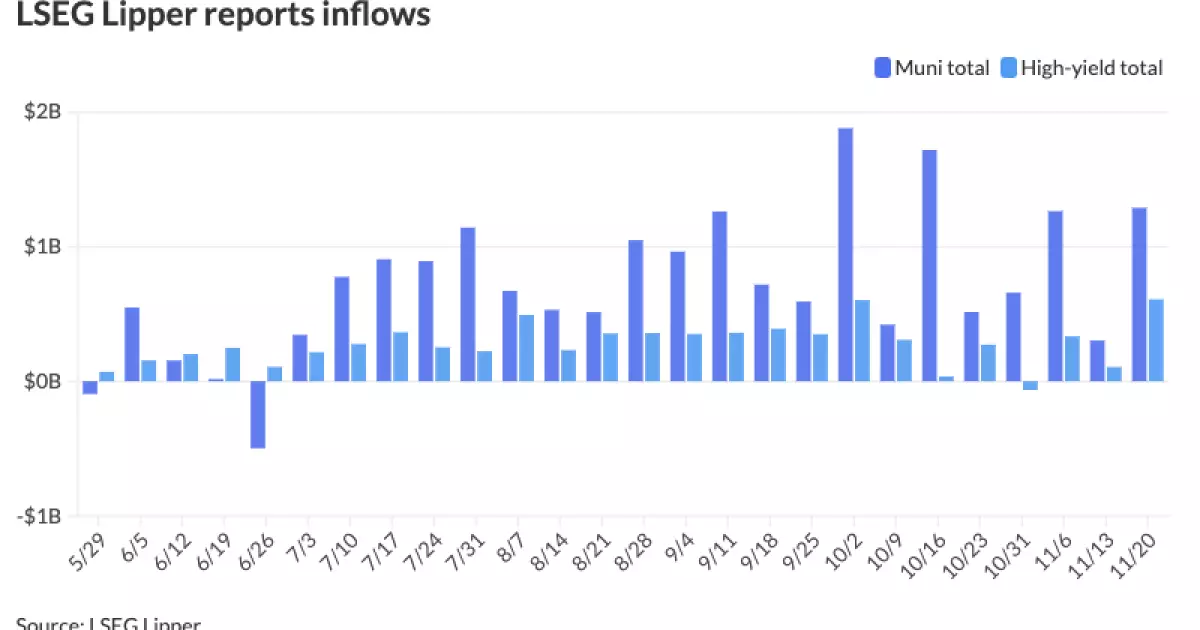The municipal bond market has shown notable resilience in the face of shifting economic indicators. With significant inflows into municipal mutual funds and relatively stable yields, investors are positioning themselves in a market that continues to offer enticing opportunities, particularly for those in higher tax brackets. As we analyze the current state of the municipal bond landscape, we’ll delve into key statistics, trends, and the broader context affecting investor sentiment.
Last Thursday, the municipal bond market experienced little change despite a substantial inflow into municipal mutual funds, which exceeded $1 billion for the week. According to LSEG Lipper, municipal bond mutual funds attracted $1.288 billion in inflows, markedly higher than the prior week’s inflows of $303.2 million. This marks the 21st consecutive week that the municipal bond sector has drawn positive inflows, demonstrating a steady confidence among investors.
High-yield municipal funds have also captured attention, recording inflows of $608.9 million—an increase from the previous week’s $150.3 million. This trend could suggest that investors are increasingly willing to take on more risk to chase higher yields, especially in a low-interest-rate environment. These inflows indicate a structural demand for municipal bonds, as investors seek refuge from the uncertainties in the broader equity markets.
While municipal bond yields remained stable for most triple-A rated curves, U.S. Treasury yields experienced fluctuations. Those under ten years saw an uptick in yield, while longer-term yields exhibited a decline. This divergence in yield movement may impact investment strategies as market participants assess the risk-reward balance of municipal bonds compared to Treasury securities.
The yield ratios in the municipal market reveal that the two-year municipal to Treasury ratio stood at 60%, with the five-year at 62%, and the ten-year at 66%. These ratios underscore the value proposition that municipals continue to offer relative to Treasuries, particularly for investors facing higher tax obligations. The increasing ratios indicate the potential for valuable risk adjustment in favor of municipal bonds as the year progresses.
Looking ahead, market analysts expect a decline in bond supply due to the approaching Thanksgiving holiday, with Bond Buyer reporting a 30-day visible supply of $5.58 billion. Observations from analysts such as Brad Libby from Hartford Funds indicate that while recent new-issue slates have been well-received, the overall supply is anticipated to sharply contract. The estimated issuance from now until the end of the year is expected to range between $25 billion and $35 billion, predominantly concentrated in the two weeks post-Thanksgiving.
The implications of reduced supply combined with healthy inflows suggest a tightening market, which could lead to upward pressure on bond prices and downward pressure on yields. This scenario could incentivize further investment in municipals, primarily driven by the need for diversification amidst economic uncertainties.
The recent elections have contributed to a sense of uncertainty, yet many fixed-income strategists believe that municipal bonds remain resilient. Cooper Howard from Charles Schwab noted that the election’s outcomes have not dealt any significant blows to the municipal market. Instead, municipals continue to provide a compelling balance of risk and reward, particularly for higher-net-worth investors.
Looking to the Federal Reserve’s forthcoming meetings, analysts are keenly focused on potential interest rate movements. Market conditions are currently pricing in an 80% probability of a 25-basis-point rate cut at the Fed’s upcoming meeting, alongside expectations for additional cuts in the following year. Such shifts in monetary policy could significantly influence municipal fund flows, as large rate movements may curtail inflows if investors perceive increased risks in the fixed-income space.
Another noteworthy development is the rise in aggregate total CUSIP requests for new municipal securities, which increased by 25% compared to September’s figures. Regions like Texas, California, and New York showcased the highest levels of new requests, indicating a robust appetite for municipal bonds across various jurisdictions. This growth in identifier requests, alongside an annual volume increase of 11.4%, further underscores the underlying strength of the municipal bond market.
The municipal bond market is adapting to a complex economic landscape marked by investor confidence, competitive yields, and varying levels of supply. As political and economic uncertainties loom, the municipal bond sector remains an attractive option for savvy investors looking to diversify and optimize their portfolios within a resilient asset class.


Leave a Reply